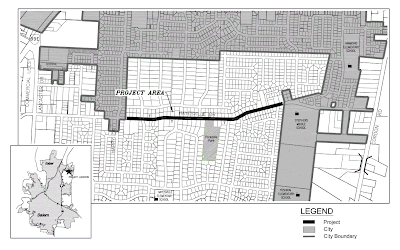
2010 was definitely the year of the sharrow, don't you think? What else directly impacted bicycling in Salem as much?
Still, wrapping up the
top stories from 2009, I was hopeful that 2010 would be bigger and better for bikes and greater transportation options. Momentum seemed to point beyond a baseline of a pilot program for sharrows. So 2010 was a little disappointing in some ways - no doubt in part a casualty of the Great Recession.
The InfrastructureSharrows on Commercial, Chemeketa and Rosemount and represented a real improvement in visibility and accomodation.

The Union St. Railroad Bridge reopened after lead abatement, and the number of people who enjoyed using it continued to climb. And West Salem City Councilor Dan Clem sponsored Bridge to Work Day to celebrate the opening -
here and
here
In several places around town, the
Keep Salem Moving $100M bond measure funded road resurfacing and reconstruction. Here the bike lane on South Commercial is ready for the final layer of asphalt. Construction of new bike lanes - always in the context of road widening - will happen in later projects mostly.
(But the bond's a mixed bag for sure, and some projects will create a host of new barriers and problems, like
the widening at Glen Creek and Wallace.)
Public Works also rolled out a
railroad quiet zone project list. One of the treatments will add
a bike-only light to Chemeketa at 12th Street.
DIY ProjectsThe best parts of the year were the DIY moments. And four stood out.

For an amazing and terrific year of
Kidical Mass rides, Kat is my bike hero for the year. It was great to see the Statesman recognize her, too.
Gary's
Smart Cycling Clinics were a great addition and helped people start navigating on city streets.
Jeff's
behind-the-scenes work on mapping low-traffic alternatives was huge and hugely cheering.

Cory started a new tradition with the
Cranksgiving alleycat - great fun and a way to collect donations for
Food Share.
People and InstitutionsThe
Transportation and Growth Management Grants kicked in and the City kicked off
the bike plan update.
Racing was in the news with the
OBRA Cross Championships at West Salem High School and Salem resident and OBRA Executive Director Kenji
won election to the BTA Board. He also wrote some winning
public advocacy.

The Boys and Girls Club started the
Flow Riders youth development riding team. Technically it started in very late fall 2009, but their coming out ride was
the Monster Cookie!
Doug
resigned from the BTA board in part over frustration that it remained such a Portland-focused entity. (Portland
reaction here.)
DisappointmentsThe gift from Sanyo Solar of an
Eneloop battery-assist bicycle seemed to languish. Instead
Portland grabbed the glory as
OMSI built the first charging station.
The Rivercrossing
Alternative Modes Study was completed, but its sensible recommendations weren't taken up with much vigor. It provided the roadmap for the sharrows, but didn't spur any "big thinking." Hopefully the bike plan update will provide that. (see below for more)
Looking Forward to 2011I look forward to seeing more of the ideas and analyses generated by the
Sustainable Cities Initiative.
A new non-profit is incorporating to work on the vision of a large loop trail in West Salem and Polk County along the river and through wine country. This is
big thinking! Look for more in January and February.
The Rivercrossing Draft Environment Impact Statement on the
proposed Highway Bridge will come out. If built, this half-billion dollar project would be the largest infrastructure project in a generation and shape the city in fundamental ways. Look for more this winter.
So what were your big bike stories for 2010? What's missing here? (How about BRMBA, the Bike Shops, Club Riding...what about your corner of the Salem area bike world?)
 Here are three design alternatives. The central railroad median is removed and the broad avenue permits various configurations of car parking.
Here are three design alternatives. The central railroad median is removed and the broad avenue permits various configurations of car parking. 






































